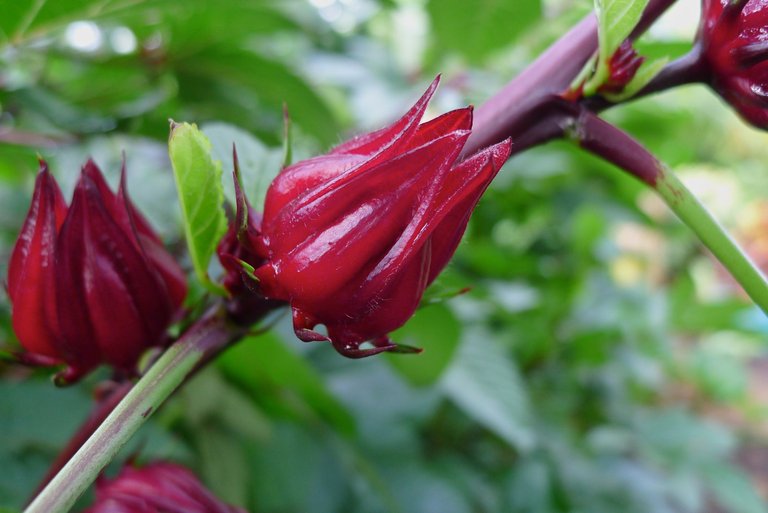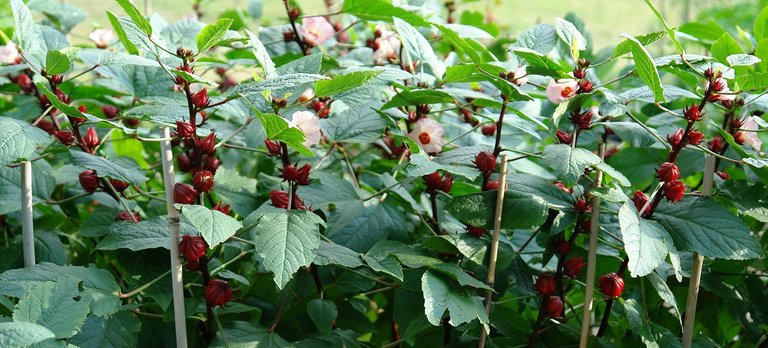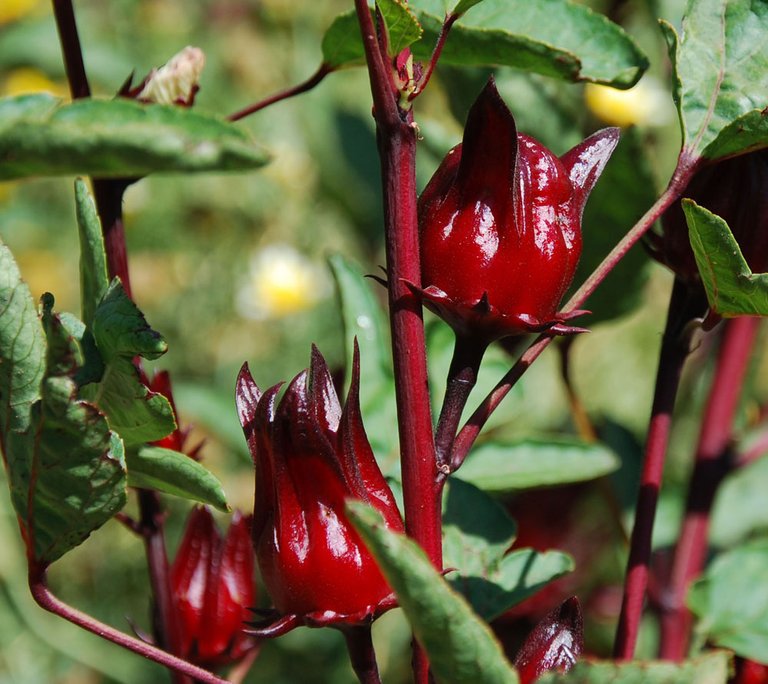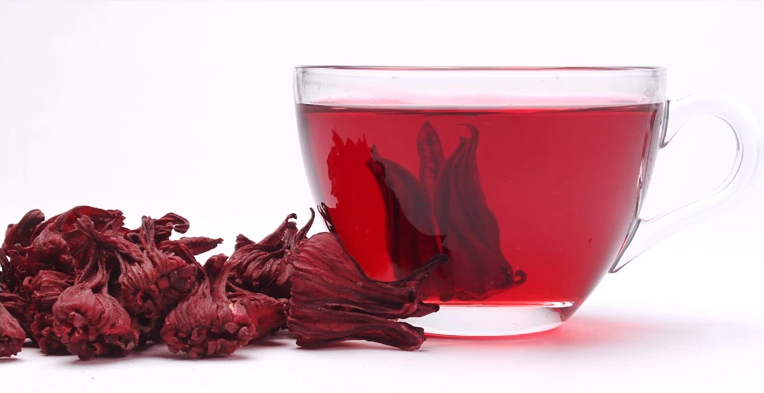Roselle (plant) Roselle (Hibiscus sabdariffa) is a species of Hibiscus probably native to West Africa, used for the production of bast fibre and as an infusion, in which it may be known as carcade. It is an annual or perennial herb or woody-based subshrub, growing to 2–2.5 m (7–8 ft) tall.
Rosella (Hibiscus rosa sabdariffa) is very famous plant in Indonesia. There are many benefit of Rosella, especially for herbal treatment. Previously, the plants flower pod is known as frambozen and materials are often used to make a framboze syrup. Just now, rosella flower sheath, known as the herbal tea drink called rosella.

Rosella flower sheath including a herbal with many used for health purposes. Rosella has a citric acid, malat acid, antosianin, hibiscin, vitamin C, protein, and flavonoid. of various substances are the most interesting is flafonoid substance called gossypectine, hibiscetine and sabdaretine, the antioxidants that are strong enough to be used against free radicals, which damage the human body.
Rosella plants growing in many countries, such as Sudan, Mexico, Jamaica, Brazil, Panama, to several states of the USA and Australia. Many people take the plants that came from Africa. For, indeed, many plants found there. Distribution can not be separated from the slave who was sent to some parts of the world.
Botanical Name : Hibiscus sabdariffa
Common Names: asam balanda, bissap, edible hibiscus, flor de jamaica, grosella, karkade, lumanda, luo shen hua, meshta, omutete, paya, queensland jam plant, rajeab, rosela, roselle, saril, sorrel, susur.
Plant Family: Malvaceae.
Plant Description
A native of tropical West Africa, it prefers warm climates. Rosella is an attractive annual shrub to 1.5 m high with large, lobed reddish leaves and attractive yellow hibiscus-like flowers. Rosellas are easy to grow, with few pest problems, hardy and productive. Most soil types are suitable, provided they are rich and well-drained. Plenty of water is needed to maintain growth, flowering and fruit development, mulching is beneficial. Three to four plants is all that is needed to produce a good crop. Plants normally begin to crop when about 3 months old and cropping may continue for 9 months or until the first frost. The fruit is ready to pick about 3 weeks after flowering, when they'll be 2 - 3 cm across at their widest part.
Planting Details
Sow When: Sow in early spring in tropical areas, rosellas need at least 5 months frost-free to bear. Rosellas need a very warm soil to germinate, preferably over 25°C. In southern areas of Australia this would be as late as October outside. Some years the soil might take even longer to warm up. So gardeners in cooler areas need to start seed indoors using a small bottom-heat unit, or the top of the water heater.
Planting Depth: Cover seed with 12 mm of fine soil.
Spacing: Plant several seeds 50 cm apart and thin seedlings to the strongest.

Plant is known in various names, such as jamaican sorell (West India), oseille rouge (France), quimbombo Chino (Spain), karkade (North Africa), and bisap (Senegal). While in Indonesia, the plant is more commonly known as green mrambos (Central Java), Asam Jarot (Padang), Asam Rejang (Muara Enim), etc..
At the plant, the flower is not nutritious, but the red sheath of its flower. Indeed, the sheath shaped like flowers, especially if it is dried. Sheath can be consumed in the form of fresh and boiled such as tea. Rosella flower sheath in the form of a fresh can be used to make foods such as pudding, salad mix, juice, candy, jelly, and syrup. Besides the delicious taste, flower sheath has the true enough of complete pharmacological effect.
Active material and Chemical Substance of Rosella flower sheath
Vitamin A equiv.: (2%) 14 μg
Iron: (11%) 1.48 mg
Vitamin C: (14%) 12 mg
Magnesium: (14%) 51 mg
Active material from the sheath of rosella flowers are grossypeptin, antosianin, gluside hibiscin, and flavonoid. Each 100 gram sheath of rosella flowers contain 260-280 mg vitamin C, Vitamin D, B1 and B2. Its vitamin C, three times stronger then black wine, nine times stronger then citrus orange, 10 times more than the fruit star fruit and 2.5-fold compared to vitamin C in guava fruit. Inition, tea contains Rosella High Calcium (486mg / 100 gr), Magnesium and Omega 3. Rosella Tea also rich of Vitamin A, fe, Potassium, Beta & Carotene acid essential.

Flavonoid interest in the sheath is very useful to prevent cancer. In fact, some scientists call flavonoid that can treat cancer, especially because the free radicals, such as stomach cancer and leukemia. In addition, rosella tea can be used for people with hypertension, heart disease, osteoporosis and throw urine (as diuretic), smooth the flow of blood (blood can reduce the thickness), prevent infection (as antibacterial, antiseptic, and anti inflammation), treat mouth sores (because containing of vitamin C), reduce blood cholesterol level, etc.. Special diabetics mellitus, in addition to lowering blood sugar, rosella flower sheath can cure disease (probably due role in flavonoid neutralize free radicals that cause damage to beta cells pancreas that produce insulin).
Plants flower sheath a red, old, thick and fleshy. The dense red color, the more sour taste with the benefit that is also bigger. Rosella tea can be made in the following way.

Take three to four fresh rosella flower bud, clean wash, and then add with hot water (one cup). After a few times, press to the sheath so that the water colored red, and then filtered.
Water can then be drunk. A day, drinking one to three cups of rosella tea. To be more comfortable, can be added a honey and lime juice.
For dried rosella flower sheath, take three to five bud and add with a glass of hot water. Wait three to ten minutes. Then, it can be drunk as much as one to three times per day. To be more delicious, can be added honey or sugar, or with ice cube.
Rosella Prevent Osteoporosis
Every person grows older in life and it is natural. Osteoporosis and premature aging is a frightening specter for almost every person today. That problems can be accelerated due to the pattern of unhealthy eating, lack of calcium, smoking, drinking alcohol, rarely exercise and stress. Aging process begins at about age 25 years and at the age of 40 years approached, calcium and other minerals in the bones decreases more quickly than it should. In the female hormone estrogen makes the decrease of bone loss becomes more rapid.

Premature aging is also characterized by damage to the skin, the skin looks dull and wrinkled and appear black moles. That is because a lack of vitamin C in the face of free radicals that can damage the skin. To prevent brittle bones and premature aging, we need to consume calcium and vitamin C in the right amount.
Herbal Rosella is effective become a herbal treatment to prevent osteoporosis

Herbal Plants Rosella (Hibiscus sabdariffa Linn.) Has the primary efficacy as an antioxidant preventing Calcification of bone, premature aging, slowing menopause and reduce the negative effects of nicotine. Herbal Rosella contains calcium, Vitamin C, D, B-1, B-2, magnesium, omega-3, beta-carotene and 18 amino acids essential for the body such as lysine and agrinine. Each 100 grams of fresh petals rosella contains 260-280 milligrams of vitamin C, vitamin B1 and B2. Vitamin C that is, 3 times a black grapes, 9 times that of citrus, 10 times larger than the fruit star fruit.
Osteoporosis Herbal Remedy using Rosella
Take three to four fresh Rosella flower bud, clean wash, and then add with hot water (one cup). After a few times, press to the sheath so that the water colored red, and then filtered.
Rosella (Hibiscus sabdariffa Linn.) flower buds
Water can then be drunk. A day, drinking one to three cups of Rosella tea. To be more comfortable, can be added a honey and lime juice.
For dried rosella flower sheath, take three to five buds and add with a glass of hot water. Wait three to ten minutes. Then, it can be drunk as much as one to three times per day. To be more delicious, can be added honey or sugar, or with Ice Cube. Using this Rosella herbal treatment will be good to prevent osteoporosis.

Because of this acid content that is cause rosella have acidic characteristic. This acid can potentially cause pain in the stomach, due to excess stomach acid. So if less precise rosella is used or can be considered to cure ulcer disease. For those who have trouble of stomach sore or ulcer, use of herbal or other materials that are acid, including vitamin C, should be limited.
To avoid stomachaches, the food or drinks that contain herbal including acid, should be consumed after the meal. That is when the stomach is not in the empty condition. Special to rosella, you can safely consume, in a way to create tea rosella.

Take 2 – 3 bud sheath Rosella is still fresh, clean, add the hot water of 200 ml. Let it for 10 minutes, may be drunk, can be added with honey. You can drink this tea, three times a week. Once a drink is 200 ml.
So far there is no information about the side effects of Rosella, related to kidney health.
More Information click Rosella
Upvote & Follow @gmbabu
Hi! I am a robot. I just upvoted you! I found similar content that readers might be interested in:
http://podoteko.com/health/herbal/herbal-benefit-rosella/
Quite informative, great job putting such a detailed post together.